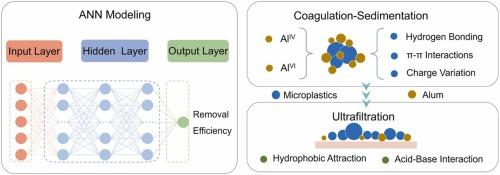揭示五种被忽视的微塑料在混凝-超滤过程中的去除行为:来自实验和预测建模的见解
IF 11.3
1区 环境科学与生态学
Q1 ENGINEERING, ENVIRONMENTAL
引用次数: 0
摘要
典型的水处理工艺对于减轻饮用水中微塑料污染的风险至关重要。实验和机器学习的结合为阐明微塑料去除行为提供了一条有前途的途径,但相关研究很少。为了解决这一空白,本研究将实验和人工神经网络(ANN)建模相结合,探讨了典型混凝-超滤过程中五种被忽视的微塑料的去除行为和机理。实验结果表明,混凝对5种微塑料的最佳去除率为37.0 ~ 56.0%,后续超滤几乎完全去除残留的微塑料。通过调整激活函数,采用批归一化方法,构建了5个人工神经网络模型并对其进行了优化,预测微塑料去除效果准确,R²值在0.9972 ~ 0.9987之间。x射线光电子能谱分析表明alv和AlVI物质、氢键和π-π相互作用参与了凝固过程。二维相关光谱探索了6个化学键(C - h、Al-O-Al、C - O、COO-、C=O和- oh)的顺序形成及其潜在机制。此外,理论计算明确了微塑料与超滤膜之间的界面相互作用,突出了疏水吸引力和酸碱相互作用的作用。这项研究扩展了我们对饮用水处理中微塑料去除的理解,提供了有价值的机制和建模见解。本文章由计算机程序翻译,如有差异,请以英文原文为准。

Revealing the removal behavior of five neglected microplastics in coagulation-ultrafiltration processes: Insights from experiments and predictive modeling
Typical water treatment processes are essential for mitigating the risk of microplastic contamination in drinking water. The integration of experiments and machine learning offers a promising avenue to elucidate microplastic removal behavior, yet relevant studies are scarce. To address this gap, this study combined experimental and artificial neural network (ANN) modeling to explore the removal behavior and mechanisms of five neglected microplastics in typical coagulation-ultrafiltration processes. Experimental results demonstrated that coagulation achieved an optimal removal rate of 37.0–56.0 % for the five microplastics, and subsequent ultrafiltration almost completely removed all residual microplastics. Five ANN models were constructed and optimized by adjusting activation functions and employing batch normalization, accurately predicting microplastic removal, with high R² values of 0.9972–0.9987. X-ray photoelectron spectroscopy elucidated the involvement of AlIV and AlVI species, hydrogen bonding, and π-π interaction in coagulation. Two-dimensional correlation spectroscopy explored the sequential formation of six chemical bonds (C–H, Al–O–Al, C–O, COO-, C=O, and –OH) and potential mechanisms. Moreover, theoretical calculations clarified the interfacial interactions between microplastics and ultrafiltration membrane, highlighting the roles of hydrophobic attraction and acid-base interaction. This study expands our understanding of microplastic removal in drinking water treatment, providing valuable mechanistic and modeling insights.
求助全文
通过发布文献求助,成功后即可免费获取论文全文。
去求助
来源期刊

Journal of Hazardous Materials
工程技术-工程:环境
CiteScore
25.40
自引率
5.90%
发文量
3059
审稿时长
58 days
期刊介绍:
The Journal of Hazardous Materials serves as a global platform for promoting cutting-edge research in the field of Environmental Science and Engineering. Our publication features a wide range of articles, including full-length research papers, review articles, and perspectives, with the aim of enhancing our understanding of the dangers and risks associated with various materials concerning public health and the environment. It is important to note that the term "environmental contaminants" refers specifically to substances that pose hazardous effects through contamination, while excluding those that do not have such impacts on the environment or human health. Moreover, we emphasize the distinction between wastes and hazardous materials in order to provide further clarity on the scope of the journal. We have a keen interest in exploring specific compounds and microbial agents that have adverse effects on the environment.
 求助内容:
求助内容: 应助结果提醒方式:
应助结果提醒方式:


